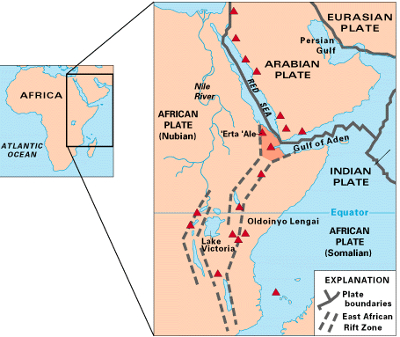The East African Rift System is a huge geologic fracture that stretches for thousands of miles across the Earth’s surface. It extends from the Middle Eastern nation of Jordan down to central Mozambique in Africa. The rift is about 30–40 miles (48–64 km) wide on average, and so large that it is easily visible from space.
The rift began to form about 30 million years ago, when geologic forces started breaking the African plate into two new plates, the Nubian and the Somalian. It continues to grow by about two and a half centimeters each year. Scientists predict that the Somalian plate will break off from the rest of Africa within 10 million years.
The rift system has two branches. The Eastern Rift Valley, which spans the system’s entire length, is the main branch. Several bodies of water fill its trough, including the Jordan River, the Dead Sea, and the Gulf of Aqaba.
 The western branch of the system is called the Western Rift Valley, or Albertine Rift. Its southernmost point lies at the northern end of Lake Nyasa (Lake Malawi). It wraps around to the west of Lake Victoria as it extends north.
The western branch of the system is called the Western Rift Valley, or Albertine Rift. Its southernmost point lies at the northern end of Lake Nyasa (Lake Malawi). It wraps around to the west of Lake Victoria as it extends north.
The rift system’s varied landscape encompasses environments that are well below sea level, as well as mountainous heights. It holds Lake Tanganyika, the second deepest lake on earth, and Lake Victoria, the second-largest freshwater lake. Due to the area’s geological instability, there are also several active volcanoes, including Kilimanjaro and Mount Kenya. The diverse terrain is home to many species of wildlife.
That wildlife once included human ancestors. Archaeologists have discovered some of the world’s most significant paleoanthropological finds in the East African Rift System. While some ancient hominins probably lived in the area, many of the bones likely originated in sediments from the surrounding highlands that washed down into the valley, and were preserved there by seasonal flooding.
Major finds include "Lucy," a nearly complete skeleton of an Australopithecus, a bipedal ape-like creature that lived nearly 3.18 million years ago. “Nariokotome Boy,” or “Turkana Boy," is another famous fossil. A member of anthropologist Richard Leakey’s team discovered the 1.5 million year old Homo erectus at Nariokotome, Kenya, which is located on the Western shore of Lake Turkana. Leakey has speculated that the dynamic nature of the Rift Valley created a range of environments that served as a catalyst for evolutionary change.
Image: Map of East Africa. Credit: U.S. Geological Survey